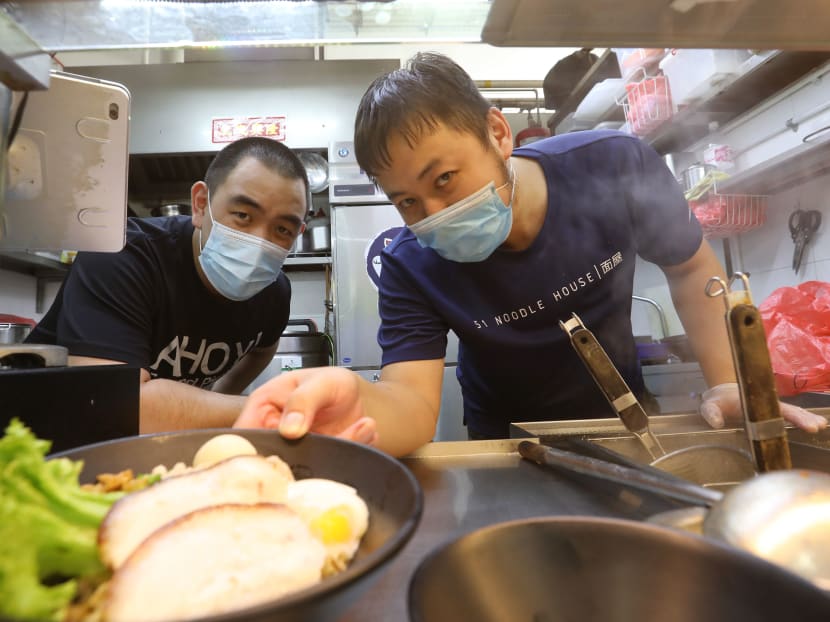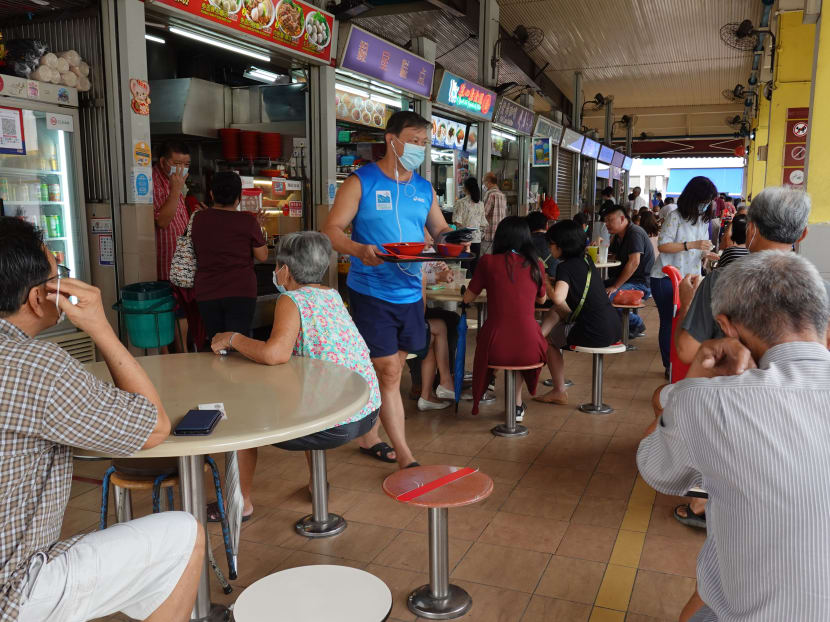The Big Read in short: What the new generation hawkers are bringing to the table
SINGAPORE — Hawker stall owner Lee Syafiq Muhd Ridzuan Lee has a dream: To be on Forbes’ 30 Under 30 list.

28-year-old Lee Syafiq Muhd Ridzuan Lee is among some young hawkers, also known as “hawkerpreneurs”, in Singapore who are not content with just eking out a living and having a stream of regular customers. They are selling traditional hawker fare with a twist, others are modernising their store front, and all are turning to social media to market their brands with an eye on making it big.
Each week, TODAY’s long-running Big Read series delves into the trends and issues that matter. This week, we look at the entry of a new wave of young hawkers and what this bodes for Singapore’s hawker culture. This is a shortened version of the full feature, which can be found here.
- Hungry and ambitious, young hawkers are aiming to serve up unique cuisines and go beyond just running a stall
- Experts note that younger hawkers aspire to higher economic goals due to the higher cost of living
- But some older hawkers have expressed reservations about what the plans by their young counterparts would mean for the hawker scene here
- The entry of a new wave of next-generation hawkerpreneurs comes as Singapore’s hawker culture is on track later this month to be inscribed on the Unesco Intangible Cultural Heritage of Humanity list.
- A successful bid would be a fillip to efforts to preserve the hawker culture, say observers
SINGAPORE — Hawker stall owner Lee Syafiq Muhd Ridzuan Lee has a dream: To be on Forbes’ 30 Under 30 list.
The esteemed list, published annually by the American magazine, lists top entrepreneurs and leaders under the age of 30.
“That’s where I hope to be in two to three years,” said the 28-year-old owner of gourmet burger stall Ashes Burnnit.
Even as other food and beverage outlets and hawker stalls have struggled to stay afloat this year due to the impact of Covid-19, Mr Syafiq has been undeterred, choosing to expand his hawker business during the economic slump.
The success of his first stall at Golden Mile Food Centre — which he bought over from his partners and rebranded in September last year — gave him the confidence to expand.
He opened a second outlet at Alexandra Village Food Centre in July and two months later, a third stall was set up at a coffeeshop at Block 69 Bedok South Avenue 3.
“We knew we were taking a risk (to open the new outlets) during this period, but we wanted to test if the brand had enough pull-factor for customers,” said Mr Syafiq.
His gung-ho spirit reflects the aspirations of some young hawkers, also known as “hawkerpreneurs”, in Singapore who are not content with just eking out a living and having a stream of regular customers.
They are selling traditional hawker fare with a twist, others are modernising their store front, and all are turning to social media to market their brands with an eye on making it big.
Mr Syafiq, for instance, says he is looking to bring “a new vibe” to hawker centres here by serving gourmet burgers rather than regular local cuisine.
He also has large neon lights on the store front of his three outlets to draw customers.
Others, such as Mr Darren Teo, 30, the co-owner of fish soup stall Seafood Pirates at Yishun Park Hawker Centre, have intentionally gone with modern, creative stall names to set themselves apart from competitors.
Ms Claire Huang of Carrot Cubes, a carrot cake stall at Cheng San Market and Cooked Food Centre, also serves her carrot cake in bowls, rather than regular brown paper to give a fancy, café-like feel to her stall.
All three are looking to multiply their outlets over the next few years.
The entry of a new wave of next-generation hawkerpreneurs comes as Singapore’s hawker culture is on track later this month to be inscribed on the United Nations Educational, Scientific and Cultural Organisation’s (Unesco) Intangible Cultural Heritage of Humanity list.

Food blogger Leslie Tay felt that unlike older hawkers who entered the trade for economic survival, young hawkers — like other young Singaporeans — aspire to achieve economic goals such as owning a condominium or a car.
As a result, most young entrants join the trade thinking about the possibility of franchising, noted Dr Tay.
“Most are not content with just opening one stall. They are in it to create a brand, start a franchise and expand to a few different stalls,” said Dr Tay, who runs food review website ieatishootipost.sg.
However, some older hawkers have expressed reservations about what the plans by their young counterparts would mean for the hawker scene here.
Mr Kang Kaiming, 62, owner of Ming Yun Famous Fried Hokkien Prawn Noodle at Block 117 Aljunied Avenue 2, said that over the years, he had observed how newer entrants try to cut costs on their operations by compromising on the quality of their ingredients.
For example, they may include monosodium glutamate (MSG) to add flavour to the soup or put in fishcake in the dish instead of other meat.
However, this leads to changes in the traditional taste of the dish, said Mr Kang.
Franchising — a common strategy for business expansion — may also compromise the quality of the food, said Dr Tay, giving the example of how some roast duck or wanton noodle stalls “drop off the foodie radar” after becoming franchised.
Franchising may result in the loss of individuality and artisan quality of the hawker, he added. “Frying a plate of char kway teow is a skill, and people come to eat that skill. It’s hard to franchise that skill.”

Despite concerns that prices could rise with young hawkers gravitating towards food which promise higher profit margins, Dr Tay believes that most of the hawker food will still be accessible to the masses, with perhaps 10 to 20 per cent offering higher prices.
Even if hawker prices rise according to inflation, Dr Tay believes that the Government will step in to ensure that hawker food remains affordable.
But to attract new hawkers to the trade, they must be able to earn a decent income, said Dr Tay.
To this end, the public must be prepared to pay higher for food that is of better quality, he added.
To strike a balance between keeping hawker prices low and the hawker business economically-viable, Professor Lily Kong from the Singapore Management University suggested allowing a range of food and prices within the same premises.
This could see different business models at play even within one hawker centre, said Prof Kong, whose research background includes culture and heritage.
She added: "The issue of cost is a complex one. For hawker food to remain attractive, cost is a significant factor, though not the only one. But if we insist on low prices that make it economically unviable, then we will drive hawkers out of business, or else expect that this is a subsidised activity. In other words, taxpayers’ monies go towards subsidising rents, for example.”
HAWKER CULTURE DEFINED
As more young entrepreneurs make their presence felt in a long-established trade, there is bound to be an impact on Singapore’s hawker culture. But first, what is the country’s hawker culture?
In her 2013 book “Eating her curries and Kway: A Cultural History of Food in Singapore”, historian Nicole Tarulevicz observed that in a society such as Singapore which has gone through huge changes in a short period, food serves as a connection to an ever-changing past.
Places where Singaporeans spend their time buying and consuming food, such as hawker centres, also hold meaning at a personal and national level as these are where Singaporeans form relationships with friends, family and colleagues or meet their neighbours.
“In a sense, that shared table or queue at a favourite stall is the nation,” says Assoc Prof Tarulevicz who teaches at the University of Tasmania.
When Unesco’s evaluation body announced that Singapore’s hawker culture had fulfilled all the criteria in the nomination process, Ms Chang Hwee Nee, the chief executive officer of the National Heritage Board (NHB), also noted that “hawker culture has evolved into a microcosm of our multicultural society, and is an integral part of our living heritage”.
“It provides a sense of identity and continuity in Singapore over generations and through urbanisation and development,” she said in a press statement.

WHAT A SUCCESSFUL UNESCO BID COULD MEAN
Stressing the need to preserve the hawker culture, Dr Tay said that in a fast-changing country such as Singapore, places and buildings which root Singaporeans to their past, such as the old National Library or National Theatre, had been redeveloped to make way for other things.
Hawker culture, on the other hand, links Singaporeans to their past better than other tangible heritage icons.
“Our hawker culture is a shared memory of where we came from. It is based on immigrants who came to Singapore long ago bringing their food and cultural influences from their home. It is that food which anchors us to past generations,” said Dr Tay.
Likewise, Mr Victor Yue, honorary treasurer of Singapore Heritage Society, said that with fewer Singaporeans cooking at home, many people will lose touch with heritage food. In this regard, it is worth preserving hawker centres as they are the “lifeline” for Singaporeans who want to keep the link with traditional meals cooked by their grandparents.
If Singapore’s hawker culture is successfully inscribed in Unesco’s intangible cultural heritage list, there will be greater impetus for stakeholders such as government agencies, hawkers and patrons, to improve the infrastructure and cleanliness of hawker centres, added Mr Yue.
Dr Tay said that if successful, the Unesco bid will improve the profile of hawkers here, with the Government putting in more resources to upgrade hawker centres and attract more patrons.
As it is, the buzz over the hawker culture has grown in the last 15 years since he started his food blog, said Dr Tay, with more people discussing issues such as keeping the hawker trade alive and how to help hawkers earn a better living.
Mr Low Teck Seng, who runs a soya bean stall at Tiong Bahru Market, said that in addition to elevating the status of hawkers, being recognised by Unesco will benefit them by drawing tourists to hawker centres once the tourism industry in Singapore picks up as the Covid-19 pandemic eases.
Young hawker Mr Teo, who co-owns the Seafood Pirates stall at Yishun Park Hawker Centre, said that with Unesco requiring state parties to update the committee on measures they have taken to maintain their intangible heritage every six years, there will be more impetus for the Government to attract new blood to the trade and keep it going.
And perhaps then, Mr Syafiq could take a step closer to realising his dream.











